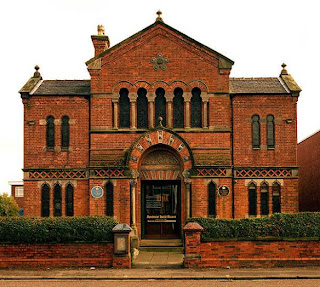 |
| Entrance to Southern Cemetery, date unknown |
"Opened in 1879, Southern Cemetery is situated on Barlow Moor Road, South Manchester.
It is the largest municipal cemetery in the UK and the second largest in Europe, with stunning gardens and pathways, and six grade 2 listed buildings, four of which are chapels.
The cemetery is also the final resting place for many great Mancunians including philanthropist John Rylands, British aviator John Alcock and former Manchester United Manager, Sir Matt Busby”*
Now as a brief introduction to Southern Cemetery this pretty much does the business.
And there is no doubting the importance of the place both for those with relatives buried there and the general public some of whom visit the cemetery for the peace and tranquilly it offers along with some impressive scenery and wildlife.
For me of course there is also the history like the other big Manchester cemeteries it was built in response to the problem of inner city church yards which had become full and were according to many endangering the health of the living.
In the small church yard of St John’s off Deansgate an inscription on the memorial records 22,000 were buried there during the 18th and 19th centuries, and in Angel Meadow 44,000 people were interred between 1789-1816.**
 |
| The Crematorium, date unknown |
All of which led to the creation of these fit for purpose cemeteries on the edge of the city.
This started with Philips Park which was opened in 1865 on the east of the city and Southern Cemetery fourteen years later.
Alongside the push for a more rational policy of dealing with the dead came the move towards cremation and the formation of the Manchester Cremation society in 1888 which in turn set up the Manchester Cremation Company in 1890 with a capital of £10,000 raised by subscription.*
It bought a plot of 6.75 acres of land close to Southern Cemetery, upon which it built a Crematorium with a chapel and a covered walk way with niches for urns. It was officially opened on October 2nd 1892, and was only the second crematorium to be opened in the country.
But the number of cremations remained low. So that in the first ten years there were only 471 which may have had something to do with the cost.
“The price of a basic cremation was £5-5s-0d and to this could be added a further £1-1s-0d for the clergyman and 15s-0d for burial of the ashes in the grounds.
A niche would cost a further £2-12s-6d in the outside columbarium or £5-5s-0d inside the chapel to which a further £1-1s-0d would be added for carving the inscription on the slab.
By comparison, a simple burial for an adult might cost as little as 10s or for a child 7s with the clergyman charging a further 2s 6d. Furthermore, burial might be available close to home while cremation would involve a time consuming and costly journey to the one crematorium in south Manchester.”
Sadly some of the registers and most other early records of the Crematorium were lost when the company's office in York Street, Manchester, was destroyed during the winter blitz of 1940. But the list of the first 412 cremations up to 1900 is available in the library at Clayton House and while those from 1900 to December 23 1940, have been lost it may be possible to find a reference in a local newspaper death notice or a memorial plaque at the crematorium.
 |
| Gravestone of Satinik Kouyoumjian |
But that still remains the vast number of gravestones which can be visited and for those with an interest in family history the City Council provides a link to the online database which holds the records of those buried in Manchester cemeteries.****
Armed with this and a map of the plots it should be possible to track down a relative some one of interest.
Pictures;,
entrance to Southern Cemetery from the Lloyd collection, gravestone of Satinik Kouyoumjian from Manchester’s Armenian community from the collection of Andrew Simpson
* Manchester Cemeteries and Crematorium
http://www.manchester.gov.uk/info/200032/deaths_funerals_and_cemeteries/5099/manchester_cemeteries_and_crematorium/5
**
http://chorltonhistory.blogspot.co.uk/search/label/Chorlton%27s%20Burial%20Scandal
*** A Brief History of Cremation: The Manchester Experience, originally published in the Manchester Genealogist Volume 37/2 in 2001,
http://www.mlfhs.org.uk/articles/37-2_cremation_history.pdf
****
http://www.burialrecords.manchester.gov.uk/


























